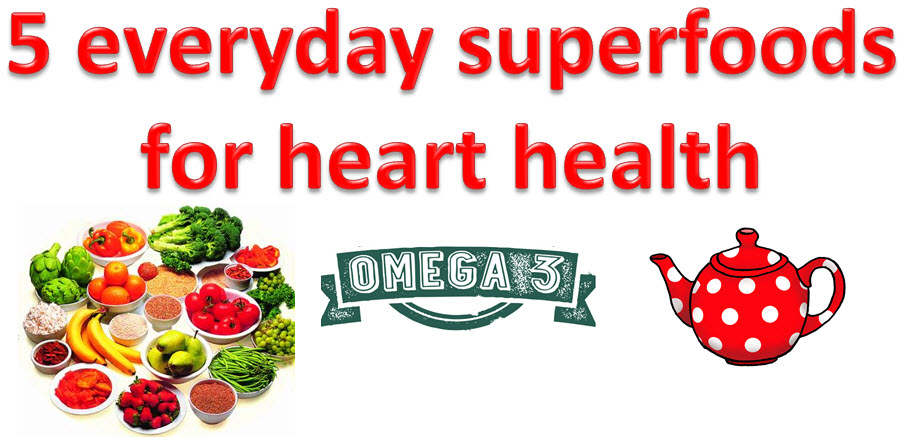5 everyday superfoods for heart health
 Fall is a time of harvest plenty and Thanksgiving. It’s a great time to take a look at what we can do to take care of our health and wellness. Did you know that making a few simple positive lifestyle changes and sticking to them over time can make a big difference in your heart health? Here are my top 5 nutrition tips to help you embrace heart health.
Fall is a time of harvest plenty and Thanksgiving. It’s a great time to take a look at what we can do to take care of our health and wellness. Did you know that making a few simple positive lifestyle changes and sticking to them over time can make a big difference in your heart health? Here are my top 5 nutrition tips to help you embrace heart health.
1. Omega-3 FATS[1]
Omega-3 fats are essential fats that your body can’t make from scratch so it must get them from food. Omega 3 fats also deliver some big health benefits, such as reducing the risk of heart disease. For example, Omega-3 fats appear to help keep the heart beating steadily and reducing the risk of potentially fatal arrhythmias. Omega-3 fats also help lower blood pressure, improve blood vessel function, and lower triglycerides – blood fats linked to heart disease and diabetes. Research has also found that omega-3 fatty acids prevent blood clots and may ease inflammation, which plays a role in the development of atherosclerosis [2]
Foods high in Omega-3 include fatty fish such as salmon, mackerel, herring, and sardines. Canada’s Food Guide recommends eating at least two servings of fish each week; a serving is 75 g (2.5 oz.).Other foods that contain omega 3 fats include some vegetable oils (Canola), nuts (especially walnuts), flax seeds, flaxseed oil, and leafy vegetables. Some foods may be enriched with omega-3 fats such as eggs, yogurt and margarine.
2. Whole grains and fibre
Research shows that people who eat more whole grains may have a lower risk of heart disease, stroke, diabetes, and some cancers.[3] To help reduce the risk of heart disease choose to get more fibre from whole grains, beans, vegetables and fruit.
Oatmeal and other whole grains such as whole wheat, barley, rye, millet, quinoa, brown rice, and wild rice also help reduce the risk of diabetes, which in itself is a risk factor for heart disease.
A healthy diet includes 25-38 grams of fibre a day and many people only get about half the amount of fibre they need. You can get more fibre in your diet by making small changes that add up over time. Boost your veggie and fruit intake (see next tip #3) and include whole grains, legumes, nuts and seeds in your meals and snacks. When grocery shopping, compare food labels and choose foods with 2 to 4 grams of fibre per serving.
3. Veggies and Fruit
Eat your F&V’s says comedian Jimmy Kimmel referring to fruit and veggies of course. I couldn’t agree more grab your F&V’s for a snack on the go, make them HALF your plate whenever you’re eating a meal! Any F & V counts and eating 5-10 servings every day may help reduce your risk of heart disease and stroke. Many F&V’s are rich compounds that can work as antioxidants in your body. Antioxidants are natural plant compounds that have powerful health benefits. The darker the colour the better. Powerhouse dark colour veggies include broccoli, spinach, red peppers, carrots, tomatoes, strawberries, blueberries just to name a few.
Tip – Frozen and canned fruit and veggies are harvested and packed at their peak, and have about the same nutritional value as their fresh version. Remember to check labels for NO added sugar or salt.
4. Nuts and seeds
Scientific evidence suggests that eating ¼ cup of nuts or seeds as part of a healthy diet can help reduce the risk of heart disease. Because they contain unsaturated fat and soluble fiber, just a small amount of nuts or seeds each day can help reduce damaging high levels LDL cholesterol. Most nuts and seeds are also rich in vitamin E, an antioxidant that is also thought to help reduce the risk of coronary artery disease or a heart attack.
5. Tea[4]
The natural plant compounds found in brewed black and green tea (camellia sinensis) are called flavonoids and have powerful health benefits. Studies published in the American Journal of Clinical Nutrition highlighted that drinking tea helps lower the risk for heart disease and stroke. Researchers in Australia found that regular consumption of 3 cups of black tea a day can result in significantly lower blood pressure. High blood pressure is a risk factor of disease and small decrease in blood pressure from dietary changes may have significant benefits.
Tea contains naturally occurring compounds called flavonoids that can function as antioxidants, but researchers are finding benefits that go well beyond. While investigators are still exploring the various mechanisms by which tea flavonoids function, studies suggest multifunctional mechanism that work in tandem to improve cardiovascular health.
[1] Harvard School of Public Health Omega-3 fatty acids:an essential contribution (Sourced 2015)
[2] Leaf A. Prevention of sudden cardiac death by n-3 polyunsaturated fatty acids. J Cardiovasc Med.(Hagerstown). 2007; 8 Suppl 1:S27-29.
[3] Dietitians of Canada, Eatright Ontario, Focus on Fibre (Sourced 2015)
[4] Am J Clin Nutr December (2013)